The demand for digital products is growing at an unprecedented rate and commanding a greater share of consumer spending each year. One thing is certain: opportunity abounds in this multi-billion dollar industry.
Whether you’re looking to cash in or simply curious at heart, we’ve gathered all there is to know about digital products. Keep reading as we unpack 100+ digital product statistics for 2024, including the most popular digital product categories, key buyer characteristics, and more.
Digital Products Statistics Highlights
- The volume of digital product transactions has increased by almost 70% in the last 2 years.
- Conservative estimates place spending on digital products at $135 billion for 2024.
- Digital products accounted for 3% of US consumer spending in 2023.
- In 2020 alone, over 2 billion consumers purchased digital products.
Digital Products Statistics
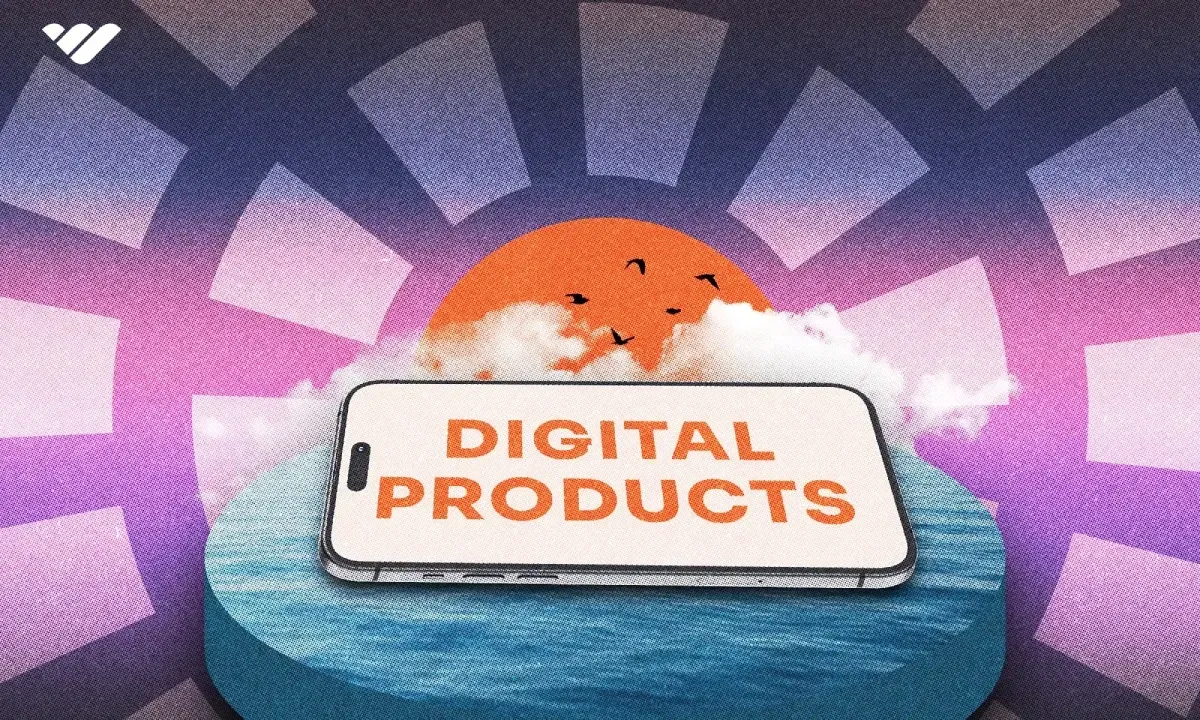
Digital products are intangible goods and services such as ebooks, apps, and streaming services delivered over the Internet. According to Mastercard1, the volume of digital product transactions has increased by almost 70% over the last 2 years.
The growth of the digital products industry is due to factors such as:
- Internet adoption - 66% of the global population2 is now on the internet.
- Mobile device adoption - 70% of the global population owns a mobile device.
- Social media use - 62% of the global population is active on social media.
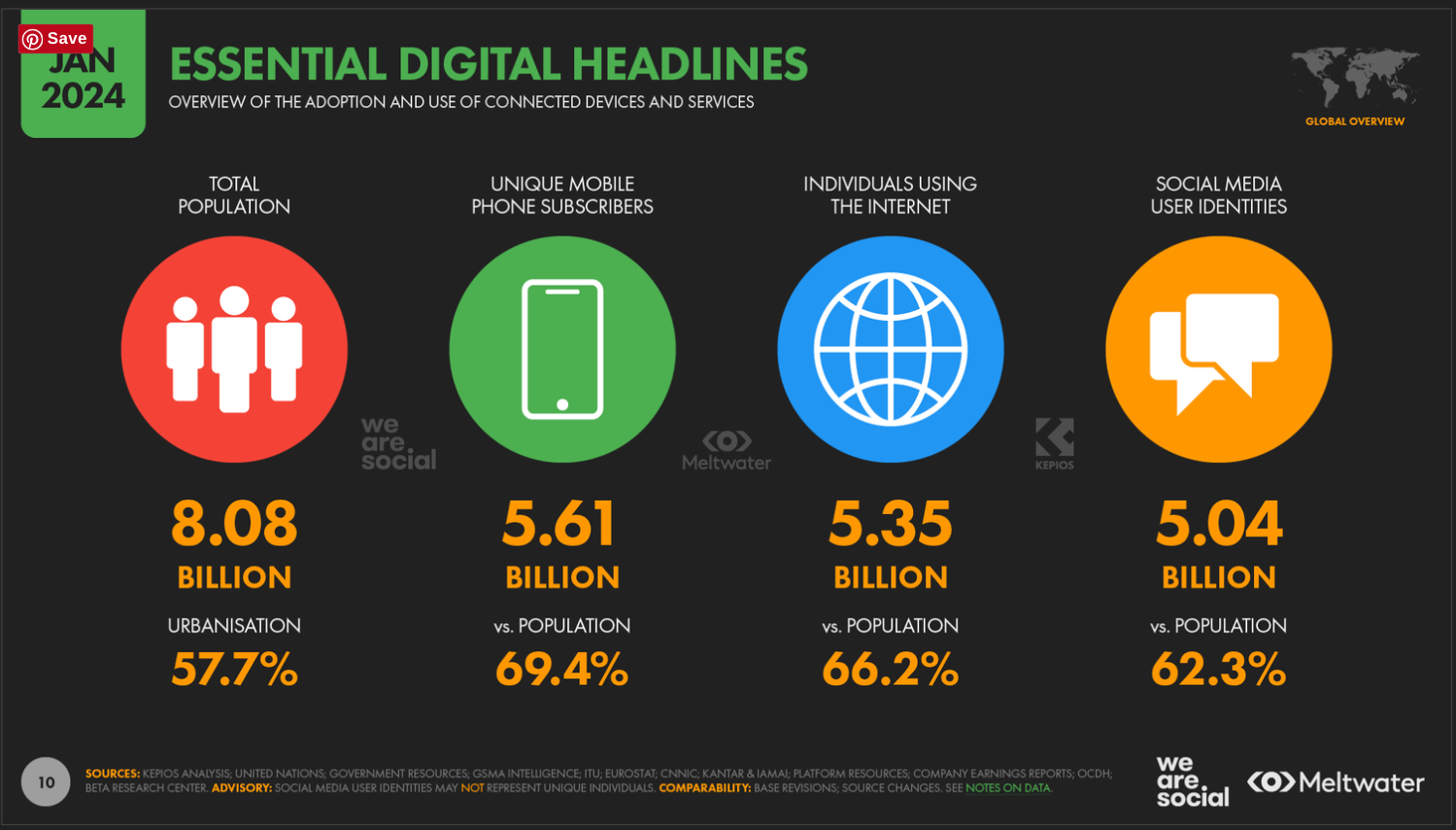
According to McKinsey, global spending on digital goods is expected to hit $135 billion3 by 2024.
Global spending on virtual goods surpassed $110 billion4 in 2021, more than double the total spend in 2015.
Daily active users of digital products surged by 54%5 between January 2020 and August 2021.
This is up from usage rates of 19% in April 2019. In 2020 alone, 2 billion consumers purchased digital products.
Ebooks

The eBooks market will generate revenue of $14.6 billion6 by 2024, an increase of 3.2% from 2023.
In terms of revenue generation, the US is expected to take the lead, pulling in over $5 billion in 2024.
The market will grow at a CAGR of 1.62%, leading to an estimated market volume of over $15 billion by 2027.
In addition, the number of ebook readers will surpass 1.1 billion, displaying a penetration rate of 14.1%—up from 13.3% in 2024.
As of December 2023, Statista reported that the most popular platform for purchasing ebooks was Amazon, with close to 70% of respondents7 in the US, UK, and Germany buying e-books there.
The Apple ebooks store was used by 18% of US ebook readers while less than 15% of global ebook readers bought ebooks directly from a publisher’s website.
According to Pew Research, 30% of Americans read ebooks8 in 2022, with unit sales of ebooks rising 8% to 526 million9.
According to Bookstat, which collects data from Amazon, Apple, and Barnes & Noble across print book, e-book, and digital audiobook formats, self-published titles drove 51% of sales due to their competitive pricing.
Music Streaming

As of 2023, the US ranked first in terms of digital music revenue10, pulling in over $15.7 billion.
This was over 3 times the value of the second largest revenue generator, China, which made $4.1 billion in the same period.
There were over 116 million streaming users in the US in 2022, while those who accessed digital music via downloads stood at over 47 million.
By 2027, the number of users streaming music is expected to hit 154 million11, with revenue from streaming services set to be the most profitable digital music format in the US.
Meanwhile, the average revenue per user for digital music streaming was estimated at over $92 in 2022.
This represents a notable increase from an average revenue per user of just under $72 in 2017.
Digital music accounted for over 50% of all the revenue12 generated by the music industry in 2021.
That was an impressive $1.1 billion that year, with the US leading as the profitable market in the global digital music industry.
In 2022, Spotify was the global leader in music streaming services13 with a market share of 30.6%.
This was followed by:
- Apple Music at 13.7%
- Tencent Music at 13.4%
- Amazon at 13.3%
Audiobooks

Revenue in the audiobook market is estimated to exceed $7.4 billion14 in 2024, an increase of 32% from 2023.
Globally, revenue is expected to grow at a CAGR of 10.44%, leading to an estimated market volume of $13 billion in 2029.
In addition, the US will lead revenue generation, accounting for over 47% or $3.41 billion of global audiobook revenue in 2024.
Further, revenue in the US is expected to grow at a CAGR of 10.55% between 2024 and 2029 resulting in a market volume of $5.63 billion.
The number of Audiobook readers is expected to hit 1.8 billion by 2029.
Meanwhile, the average revenue per user is expected to be $5.46 in the same year.
Podcasts

As of March 9, 2024, there were over 4.1 million podcasts15 according to the Podcast Index.
Additionally, 353,338 shows were published in the last 30 days and 414,795 in the last 60.
The number of podcast listeners is expected to increase to over 800 million users16 in 2025.
That's up from 485 million consumers worldwide in 2020.
In 2023, the global podcasting market was worth $27 billion.
Driven by the growth of podcasting platforms and smartphone use, the market is estimated to grow at a CAGR of 27.8% and exceed $233 billion between 2023 and 2032.
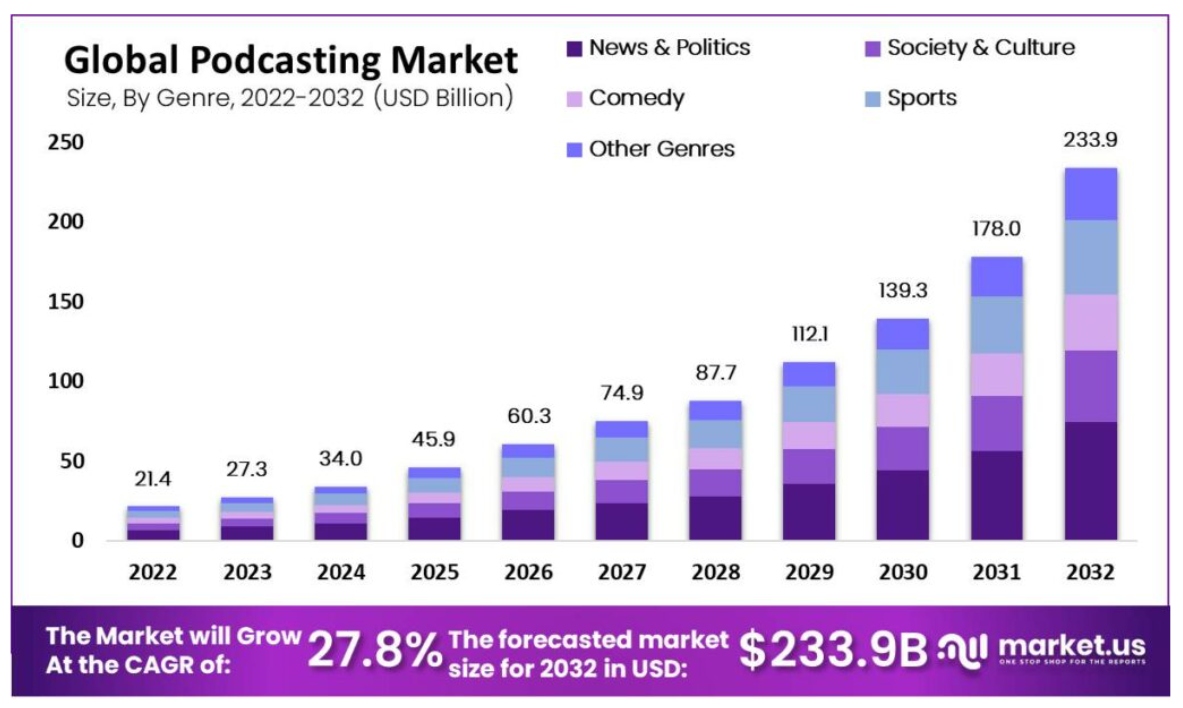
Of the 34% of consumers accessing podcasts, 12% accessed a show relating to news and current affairs17 in 2023.
- Within the podcasting market, the News and Politics segment was the most popular, accounting for 31.7% of total market share18.
- Interviews dominate the podcasting market with a market share of over 30% and a CAGR of 27.8%.
- Solo podcasts are a fast-growing segment, with a market value of 25.7% and a CAGR of 28.2%.
Key players in the podcast market include:
- Spotify Technologies: Held a 32.5% share of the global podcast listening market in 2023.
- Audacy Inc: Held a 13.1% share of the listening market in 2023.
- SoundCloud Ltd: Held a 3.7% share of the global podcast listening market in 2022.
- Tunein Inc: Held a 5.4% share of the listening market in 2022.
Video Streaming

The global video streaming market is expected to exceed $108 billion19 in 2024.
This represents a revenue growth rate of 13.2% from the previous year.
In 2024, the US will generate around $43 billion in video streaming revenue, emerging as the market leader.
The US market is dominated by Netflix, which has a large range of original content and a large global subscriber base.
The average revenue per user in the video streaming market is expected to hit $76.58 in 2024.
In addition, the user penetration rate will be 18.3% in 2024 and is expected to reach 20.7% by 2027.
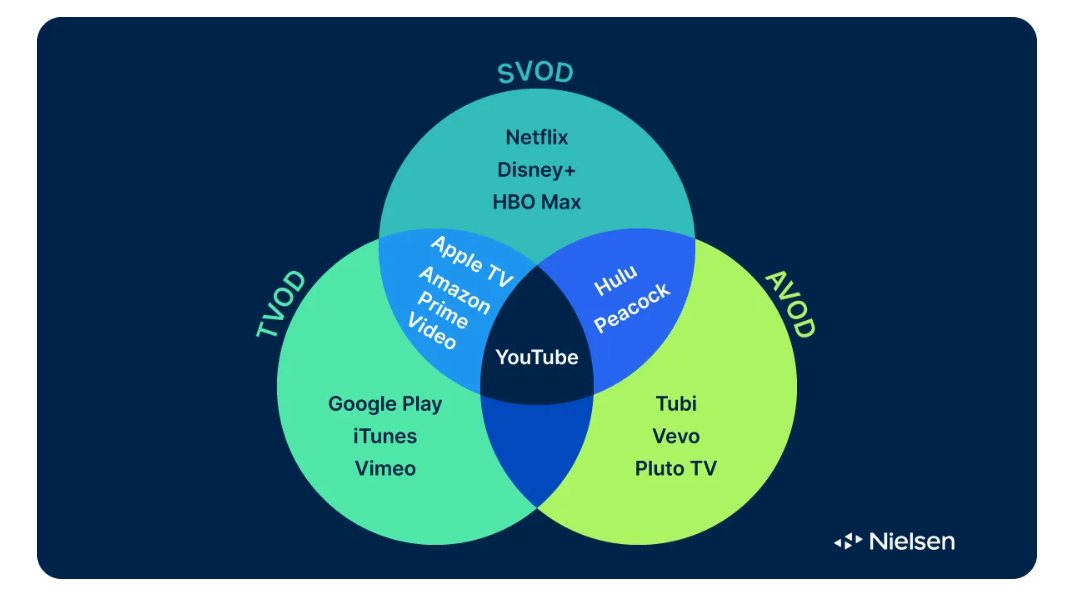
According to further projections, the market will experience a CAGR of 8.3% between 2024 and 2027, leading to a market volume of $137.7 billion.
This will be driven by the growth in video streaming users, who, according to estimates, will exceed over 1.6 billion by 2027.
In 2023, audiences in the US alone streamed 21 million years’ worth of video.
This represents a 21% increase from the 17 million years they streamed in 2022.
Video streaming audiences had access to over 90 different streaming platforms20 at the end of 2023, up from 51 in 2020.
Together, these platforms offered audiences just under 1 million unique titles and existing favorites to choose from.
As of November 2023, the key video streaming players21 in the US were:
- Amazon Prime - 21%
- Netflix - 20%
- Max - 15%
- Disney+ - 13%
- Hulu - 11%
- Paramount - 7%
E-Learning

The e-learning market was worth over $210 billion in 2021 and is projected to be worth $840 billion22 by 2030.
Growing at a CAGR of 17.5% the industry presents massive opportunities for technology providers, instructional material publishers, and more.
Meanwhile, the online education sector is estimated to be worth $185 billion in 202423.
The market is expected to grow by a CAGR of 8.61% to exceed $257 billion by 2028.
Between 2011 and 2021, the number of learners reached by massive online courses (MOOCs) increased from just 300,000 to a staggering 220 million24.
Revenue in the MOOC market will hit $22 billion in 2024, and grow at an impressive CAGR of 40% to exceed $119 billion in 2029.
Revenue from instructional materials increased 13%25 between 2018 and 2022.
This includes textbooks, workbooks, review books, standardized tests, digital textbooks, course materials, and other e-learning tools such as homework managers.
Software

The global software market is expected to generate revenue of over $698 billion26 in 2024.
This represents a 6.04% increase from 2023. The growth of the global industry has been driven by the increasing adoption of digital technologies, the demand for cloud-based solutions, and the need to improve efficiency.
Global spending on software is projected to hit $865 billion in 2024.
Enterprise software, which dominates the market, is expected to generate more than $292 billion in 2024. Additionally, the majority of revenue ($353 billion) in the industry will be generated in the US.
The global SaaS market was worth over $273 billion27 in 2023.
Software as a service (SaaS) or the ability to access software through the internet without downloads is set to grow to an impressive $908 billion by 2030.
The Metaverse

The global metaverse will be worth $937 billion28 by 2030.
Blending physical and digital worlds, the metaverse market is expected to grow at a CAGR of 41.6% between 2023 and 2030. Additionally, Gartner29 predicts that by 2026:
- 25% of people will spend at least one hour a day in the metaverse for work, shopping, education, and entertainment.
- 30% of organizations will have products and services ready for the metaverse.
As of June 2023, Metaverse usage among consumers was 10%30.
Additionally, 32% of respondents in a PwC report were familiar with the technology despite never having used it.
In a 2022 McKinsey report, over 79% of consumers active on the metaverse made a purchase31.
The same report estimated that the potential impact of the Metaverse would be $5 trillion by 2030 and that this would vary across industries. For example:
- Ecommerce - $2 trillion to $2.6 trillion impact.
- Academic Virtual Learning - $180 billion to $270 billion impact.
- Advertising - $144 billion to $206 billion impact.
- Gaming - $108 billion to $125 billion impact.
Cryptocurrencies
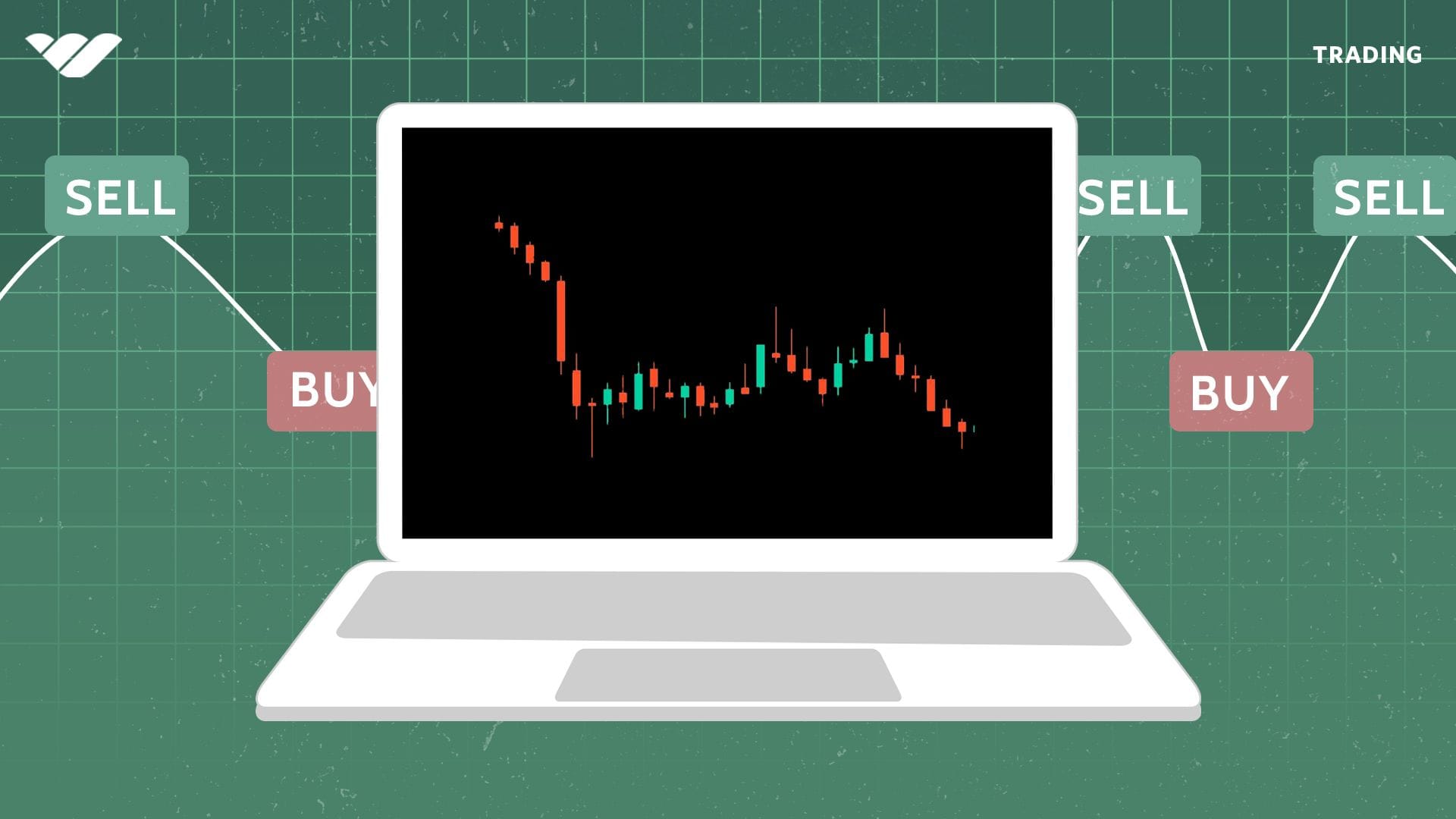
As of January 2024, 9.7% of internet users aged 16 to 64 owned cryptocurrency.
Consumers in Turkey had the highest numbers of ownership 22%, followed by Thailand 19.5% and Argentina 17%, while Ghana (2%) and Morocco (1%) had the least. Consumers aged 25 to 24 were more likely to own cryptocurrency while consumers aged 55 to 64 were least likely.
According to Statista, the cryptocurrency market is estimated to be worth $51 billion32 in 2024, with the highest revenue coming from the US ($23.2 billion).
Revenue is expected to grow at a CAGR of 8.62% and exceed $71 billion by 2028. Total users in the crypto market are also expected to reach close to 1 billion users in the same year.
Additionally:
- User penetration will be 10.76% in 2024 and is projected to hit 12.4% by 2028.
- The average revenue per user in the cryptocurrency market will be $61.8 in 2024.
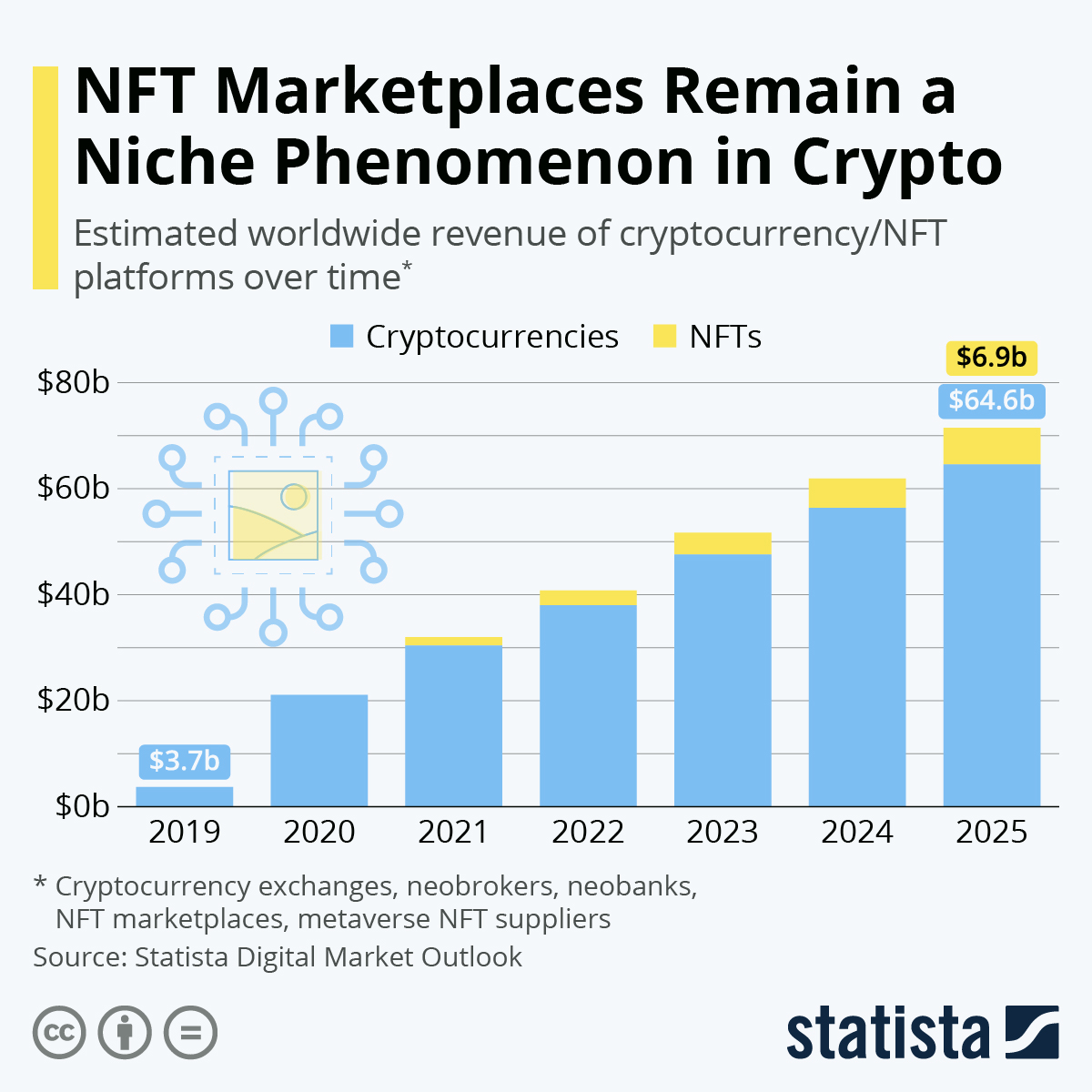
NFTs

The NFT market is expected to bounce back in 2024, hitting close to $2.4 billion33 from $1.6 billion in 2023.
Over $1.1 billion of this revenue will be generated in the US.
The market is projected to grow at a CAGR of 9.1% and clear over $3.3 billion by 2028.
In that same year, the number of NFT users is expected to surpass 16.4 million, with a user penetration rate of around 0.2%.
The NFT market surged by 750% between 2018 and 2021, increasing from $41 million to a staggering $25 billion.
However, by next year, the hype had died down, with trading volume on OpenSea, one of the biggest marketplaces at the time, falling by 80% between February and March 2022.
Mobile Apps

Global consumer spending on premium apps, in-app purchases, and subscriptions across the App Store and Google Play will reach $270 billion per year34 by 2025.
This is almost 2.5 times what consumers in 2020 spent. The same forecast further reports that:
- The App Store will see a CAGR of 21% reaching $185 billion per year by 2025.
- The Google Play Store will grow at a CAGR of 17%, hitting $85 billion per year by 2025.
- Spending across non-game apps will reach $107 billion, while mobile games will reach $78 billion.
- Europe will lead spending globally, reaching $48 billion in spending by 2025.
Additionally, global app installs across both platforms will grow by a CAGR of 10%, exceeding 230 billion in 2025.
The largest uptick in installs will come from the Play Store which is set to grow by a CAGR of 11.5% to hit $187 billion by 2025. Meanwhile, App Store installs will see a growth rate of 4.6% or $43 billion.

The global mobile app market was valued at $228.98 billion in 202335 and is expected to grow at a CAGR of 14.3% between 2024 and 2030.
Fueling the mobile app market is the sheer number of global mobile phone users. There were over 5.6 billion unique mobile phone users in the world as of January 2024.
The mobile gaming segment accounted for the largest share of revenue(34%) in the mobile app market in 2023.
Other major revenue-generating segments were:
- Retail & Ecommerce
- Music & Entertainment
- Social Networking
In the fourth quarter of 2023, global consumer spending on mobile apps was $69.9 billion.
As of Q1 2023, a total of 26.9 billion apps were downloaded on the Google Play app.
Gaming

As of January 2024, the global video game market was worth $396.2 billion36, accounting for the largest share of digital media (movies, TV shows, ebooks, music, etc.) revenue.
This is up from around $347 billion in 2022, with Statista reporting that key revenue generators in Q1 2023 were Tencent ($7.56 billion) and Sony ($4.38 billion).
In 2025, it is estimated that the global gaming market37 will exceed $503 billion.
By 2028, gaming industry growth could almost exceed $704 billion. Inkwood Research estimates further place the market’s growth at a CAGR of 11.6%, leading to a potential market volume of over $1 trillion38 in 2032.
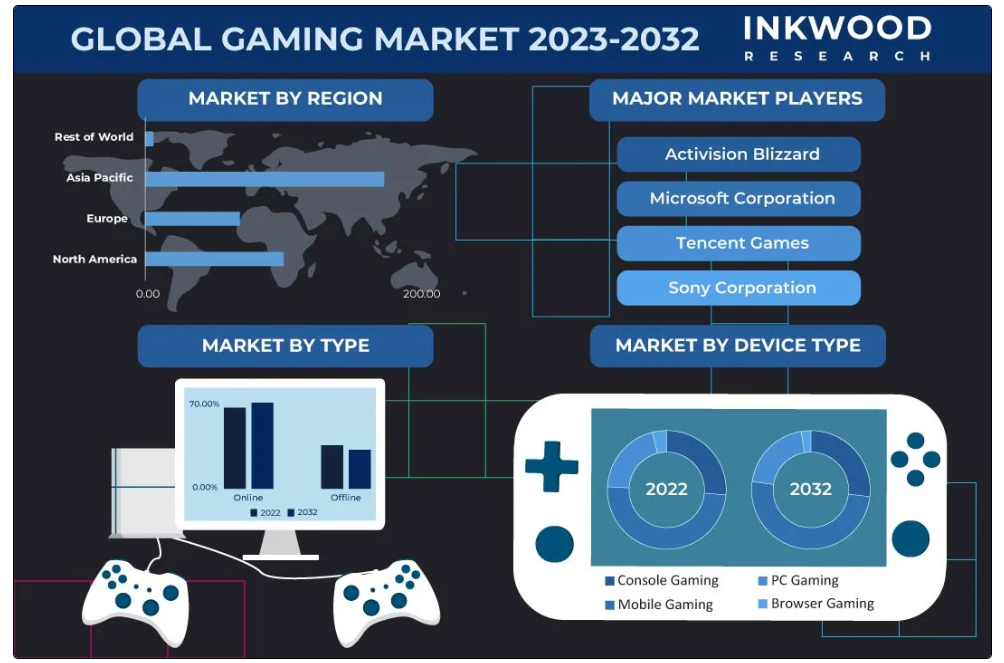
The market for gaming skins could reach $70 billion by 2024, up from $40 billion in 2020.
The intersection of fashion and gaming in the virtual sphere continues to grow. In 2021, 30% of spending on virtual goods was attributed to virtual fashion. In a notable case, Gucci sold a virtual version of its Dionysus bag for the equivalent of $6 on Roblox. This later led to bids of more than $4,000 per bag when they were resold on the secondhand market.
The cloud gaming market had a growth rate of 62.5% in 2023.
Cloud gaming allows players to play games on their devices through an online connection without the need for dedicated gaming hardware or local installation.
The Big 3 video gaming companies accounted for 29% of total gaming industry revenue39 in 2022.
The big 3 in the video gaming industry were:
- Sony - 13% market share.
- Microsoft - 8% market share.
- Nintendo - 7% market share.
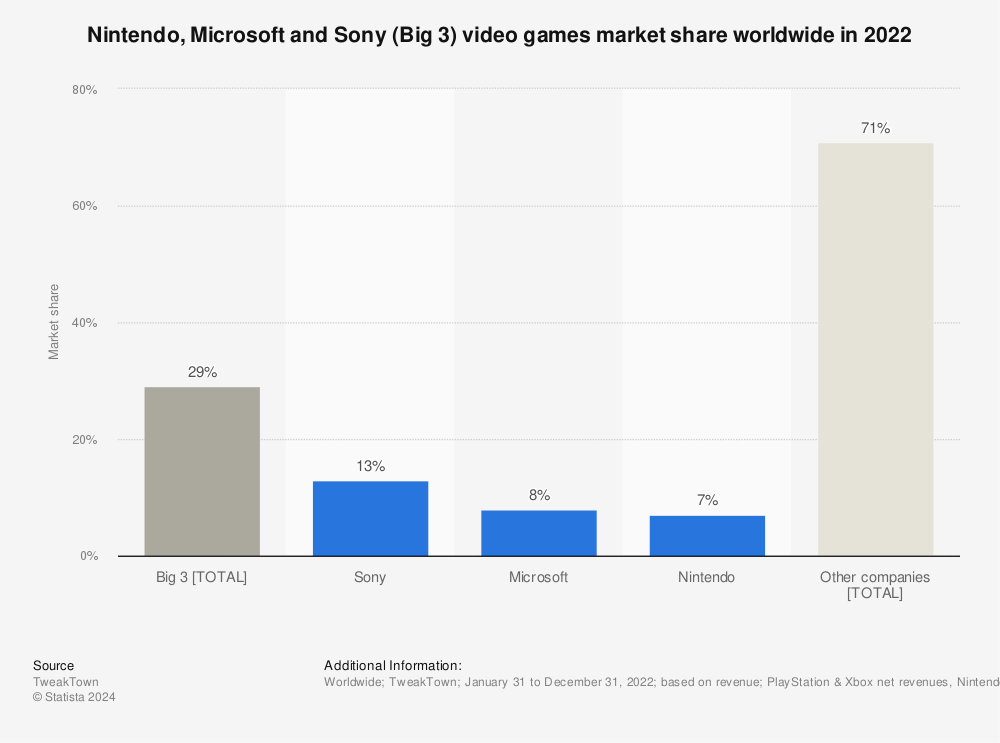
Digital News
22% of consumers preferred to access news via a website or app in 2023.
That’s down 10% since 2018, pointing to younger consumers’ preference for accessing news through social media, search, and mobile aggregators.
The average proportion of consumers that pay for online news has remained at 17% since 2021.
News subscription rates were highest in:
- Norway (39%)
- Sweden(33%)
- Australia (22%)
- Finland (21%)
- USA(21%)
Digital Products Buyer Statistics
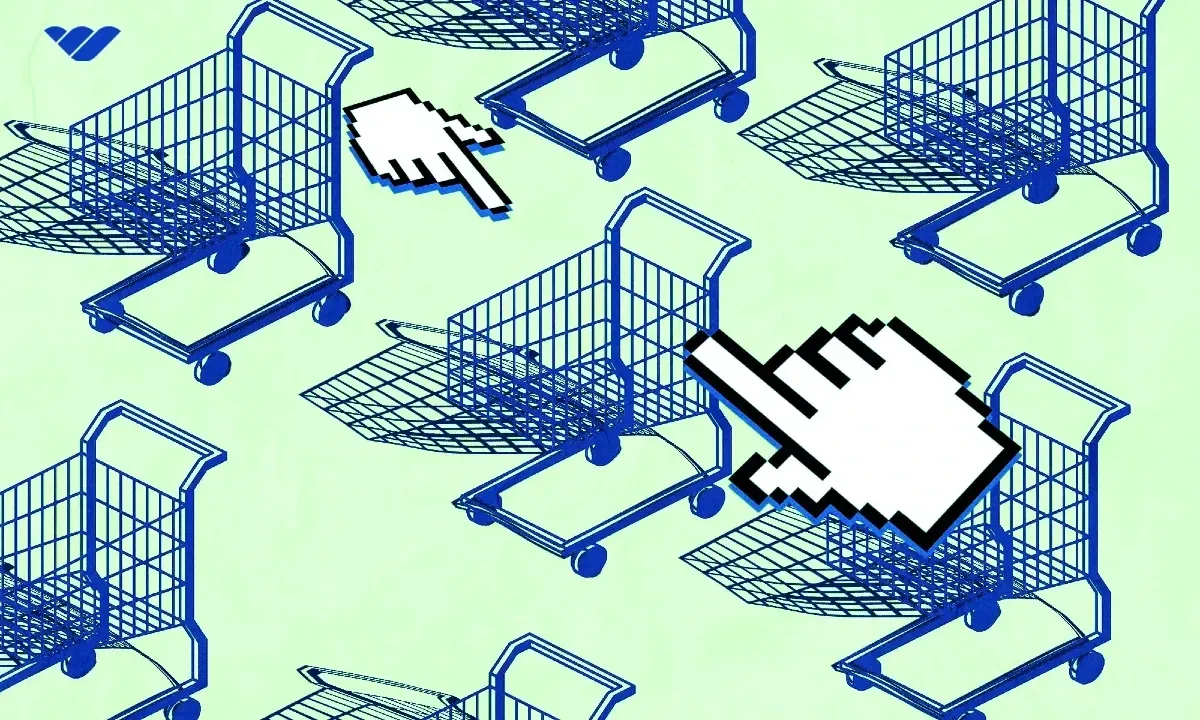
A 2024 DataReportal report found that 77% of global internet users aged between 16 and 64 watched streams and on-demand TV.
In addition:
- 68% read online press content.
- 65% listened to music streaming services.
- 62% listened to podcasts.
17% of internet users aged 16 to 64 listened to audiobooks each week as of January 2024.
Globally, user penetration is expected to hit 18.7% in 2024 and 21.7% by 2029.
As of January 2024, the typical internet user spent 6 hours and 40 minutes online each day.
During this time, internet users split their time between various digital products related to:
- Finding information - 61%
- Keeping in touch with loved ones - 57%
- Watching videos, TV shows, or movies - 52%
- Keeping up with news and events - 52%
- Learning how to do things - 50%
- Listening to music - 45%
- Playing games - 29%
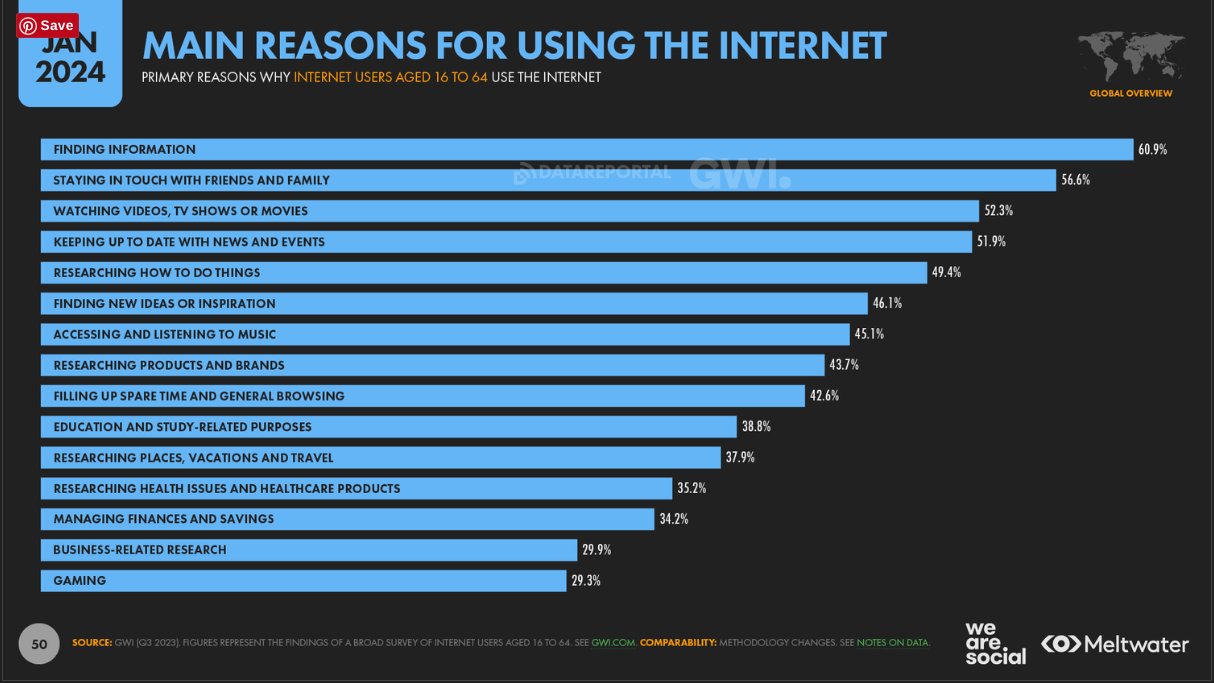
Internet users spent an average of 3 hours a day streaming, down 8.2% or 17 minutes from 2023. They spent the next chunk of daily time on social media (2 hours and 23 minutes), also down 6% or 8 minutes from the previous year.
Additionally, internet users also spent:
- 1 hour 41 minutes a day reading online press media (down 22% or 30 minutes).
- 1 hour 25 minutes a day on music streaming services (down 13% or 13 minutes).
- 49 minutes a day listening to podcasts (down 20% or 13 minutes).
- 1 hour and 2 minutes gaming (down 17% or 12 minutes).
The same report also found that as of Q3 2023, 30% of internet users aged 16 to 64 paid for streaming services each month.
- Consumers in Norway (51%), Mexico (49%), and Brazil (49%) had the highest numbers of internet users paying for TV and movie streaming services.
- Meanwhile, Bulgaria (11%) and Russia (5%) had the least.
- Consumers aged 25 to 34 were more likely to pay for streaming services while internet users aged 55 to 64 were the least likely to pay.
As of Q3 2023, 23% of internet users aged 16 to 64 paid for streaming music services each month.
- Consumers in Sweden (43%), Norway(42%), and Mexico had the highest number of internet users paying for music streaming services.
- Meanwhile, Bulgaria (8%) and Ghana(7%) had the least.
- Consumers aged 25 to 34 were more likely to pay for music streaming services while internet users aged 55 to 64 were the least likely to pay
According to Deloitte, digital products accounted for 3% of US consumers40 wallets in 2023. Spending on digital products was much higher41 for younger consumers, accounting for as much as 3.2% of Gen Z monthly spending.
The demand for digital goods and services is fast approaching major categories such as clothing and electronics where consumers spend 3.8% and 3.4% of their monthly budgets respectively.
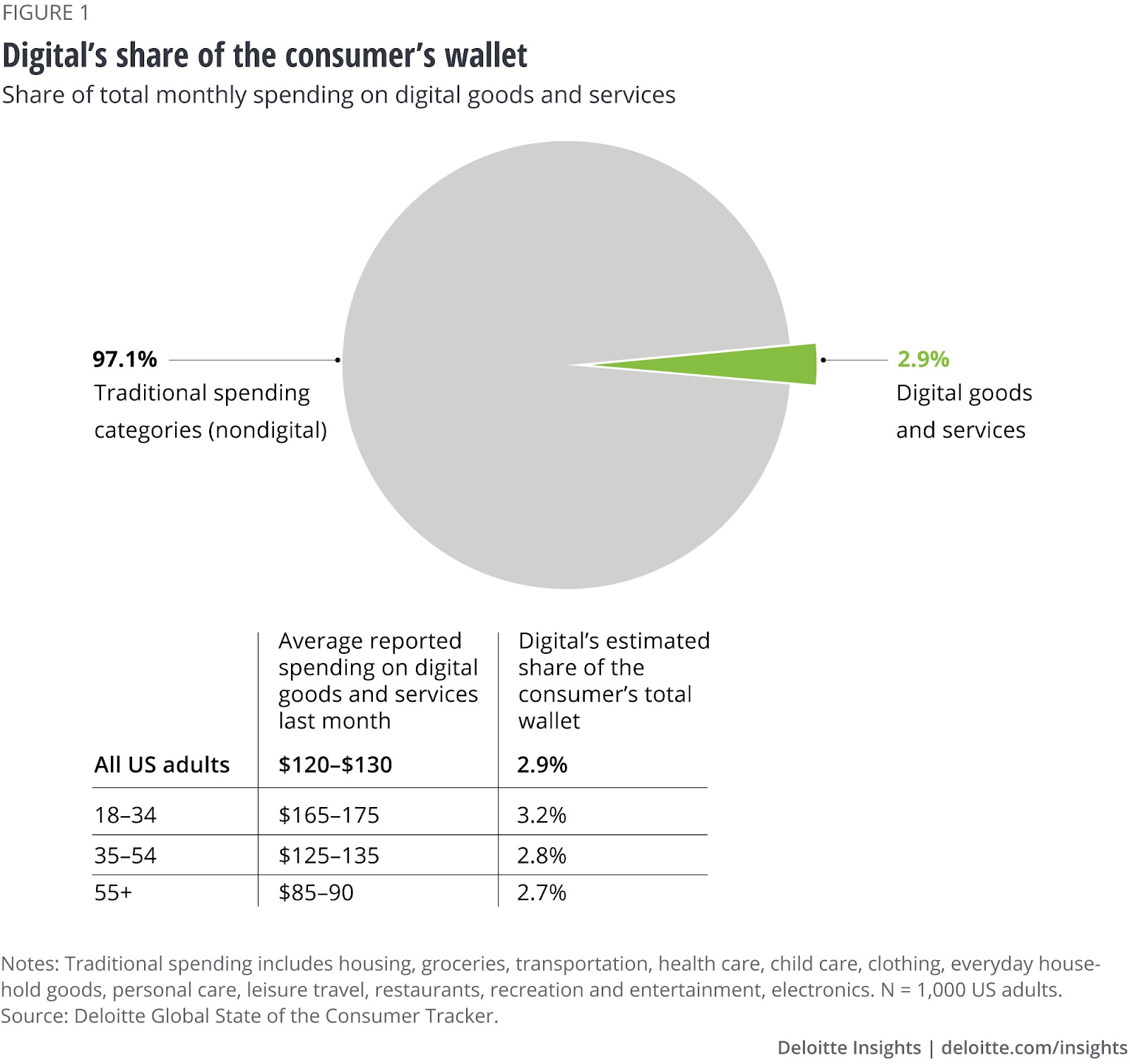
US adults spent between $120 and $130 per month across 12 digital product categories.
- Consumers aged 18 to 34 spent the most, at 3.2% of their monthly budgets, or between $165 to $175.
- Consumers aged 35 to 54 spent between $125 to $135 or 2.8% of their monthly budgets.
- Consumers over 55% spent the least, at 2.7% of their monthly budgets or between $85 and $90
Overall, between December 2022 and January 2023, digital products accounted for 12% of consumers' discretionary spending.
The digital product categories consumers spent on included:
- Streaming and entertainment services - over 60%
- Bundled services - close to 60%
- Video game and in-game purchases - close to 20%
- Computer software and mobile apps - over 10%
In terms of the actual value of spending, consumers spent an average of $40 monthly on streaming platforms as well as:
- $83 in VR content experience.
- $90 in crypto and digital collectibles.
- $55 in gaming and in-game purchases.
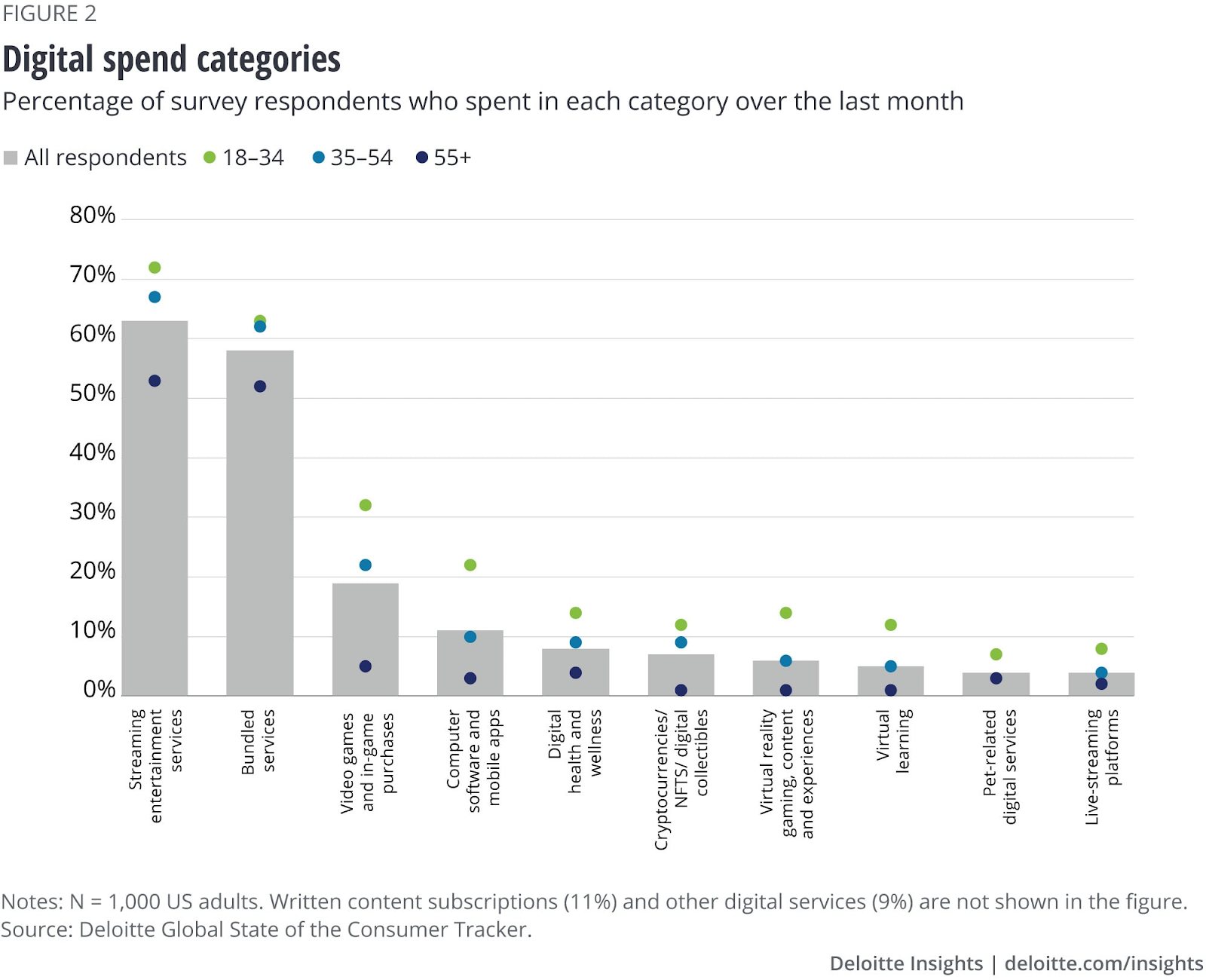
As of January 2023, 31% of internet users42 paid for a movie or streaming service, making it the most popular digital product purchased by global consumers.
In second place were music streaming services, with 24% of internet users paying for them monthly. This was followed by:
- Music downloads - 20% of internet users
- Mobile apps - 18% of internet users
- Mobile games - 17% of internet users
- Movie downloads - 17% of internet users
- eLearning materials - 14% of internet users
Digital Products Marketing Statistics

Whether you’re selling or looking to sell digital products, knowing the best marketing channels to use is crucial to your success. Let’s explore some of the most important, data-backed strategies for marketing digital products.
Hubspot43 reported these key digital marketing statistics for 2024:
- The average website had a click-through rate of 13%.
- The average conversion rate across all ecommerce sites was under 2%.
- Email marketing was one of the most effective channels for driving conversions, with a 2.8% conversion rate for B2C brands and a 2.4% conversion rate for B2B brands.
- Companies with active blogs produced an average of 67% more leads per month than companies that didn’t.
- 86% of consumers recalled podcast ads more than any other channel.
According to a 2024 Hubspot report, the marketing channels that resulted in the highest return on investment ROI44 in 2023 were:
- SEO - 16%
- Social media - 16%
- Paid social media content - 14%
- Email marketing - 14%
- Content marketing - 14%
In 2024, 87% of marketers plan to increase their investment in mobile messaging through channels like SMS, Facebook Messenger, and WhatsApp.
20% of marketers globally use mobile messaging, with 10% calling it a major driver of ROI. Additionally, personalized messaging has:
- 120x ROI.
- 50% better customer re-engagement.
- 21% increase in sales conversions.
As of April 2023, Data Reportal reported that there were over 5 billion social media users45 worldwide, representing 60% of the total global population.
This has positioned social media as a prime marketing channel for brands supplying both physical and digital products.
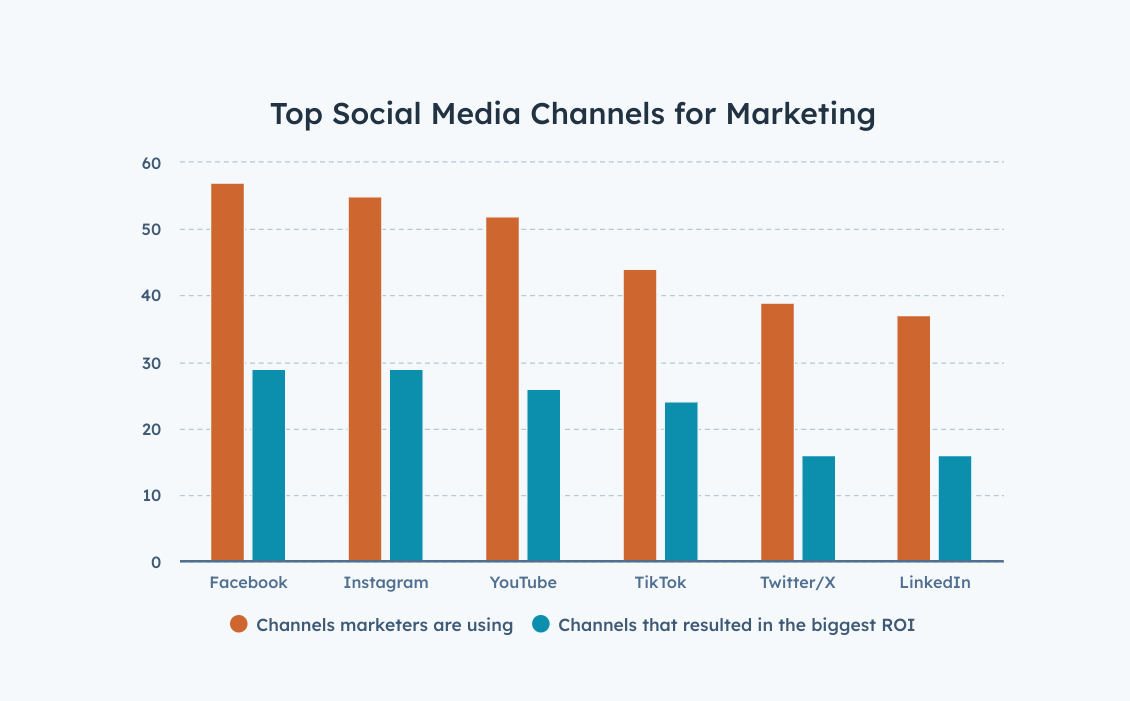
The same report found that potential ad reach and average costs per 1000 impressions (CPM) for the biggest social networks stood as follows:
- Facebook - 2.25 billion users with an average CPM of $7.19.
- YouTube - 2.53 billion users with an average CPM of $9.68.
- Instagram -.1.63 billion users with an average CPM of $7.91.
- TikTok - 1.09 billion users with an average CPM of $10.
- LinkedIn - 922 million users with an average CPM of $6.59.
Digital Products Piracy Statistics

As per a 2022 MUSO report, online video content piracy costs the global media sector $75 billion yearly46.
- Piracy site visits surpassed pre-pandemic levels and were projected to be 13% higher than in 2019.
- This figure is expected to almost double to over $125 billion by 2028 representing an annual growth rate of 11%.
While the same report also found that Europe and APAC dominated the digital piracy landscape in terms of absolute volume, the US, India, and Russia accounted for almost 30% of video piracy demand.
- The US led the charge with an 11% share in global pirate site visits in H1 2023, up from 9% in 2018.
- India followed closely behind with an 11% share in global pirate site visits in H1 2023, up from 4% in 2018.
- Russia had a 6% share in global pirate site visits in H1 2023, down from 4% in 2018.
- The UK had a 3% share in global pirate site visits in H1 2023, remaining at 3% since 2018.
- Canada had a 2% share in global pirate site visits in H1 2023, up from 2% in 2018.
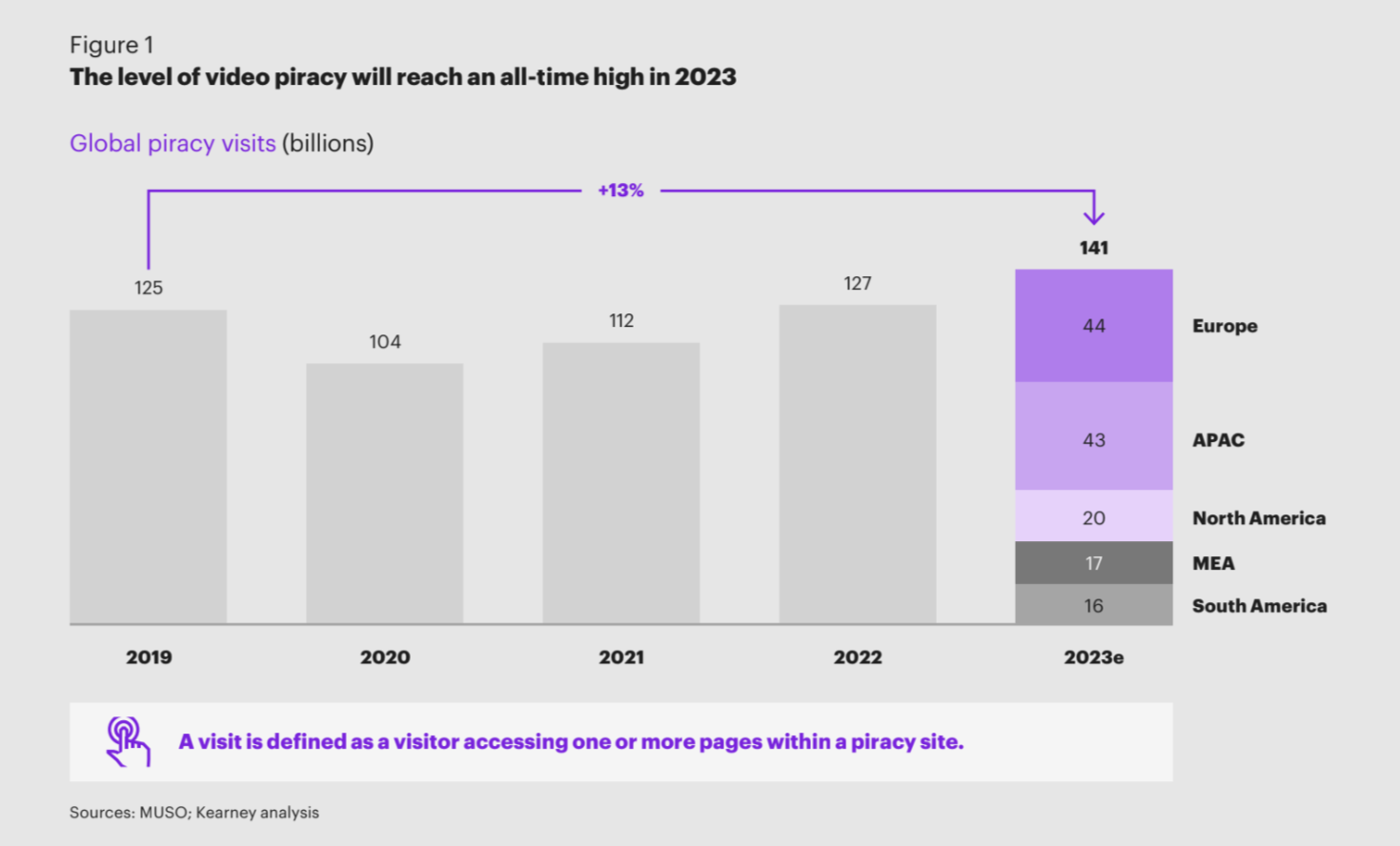
Globally, on-demand movies and TV shows represented 92% of all piracy visits, with live sports making up the rest.
- In terms of TV shows the top pirated categories included Drama (22%), SciFi (14%), and Action (14%)
- In terms of Movies the top pirated categories included Action(15%), Drama (13%), Thriller(11%)
The demand for unlicensed anime content has surged, increasing by 15% between H1 2020 and H1 2023.
This demand was fueled by the 39% increase in anime titles in the top 1000 TV titles during the same period. Between September 2022 and September 2023, anime titles accounted for 60% of the most in-demand titles globally.
According to Revenera47, 37% of software worldwide was unlicensed in 2023.
In addition, the global commercial value of unlicensed software was $46.3 billion. The commercial value of unlicensed software in North America and Europe alone was over $19 billion, or 41% of the global value despite both regions having below-average piracy rates (16% and 26% respectively).
In a separate Revenera survey of over 450 global technology leaders, 40% cited software piracy as a major problem in 2023, up from the 17% reported in 2022.
The same report found that as of November 2023, the top 5 countries using pirated software were:
- China
- Russia
- United States
- India
- Brazil
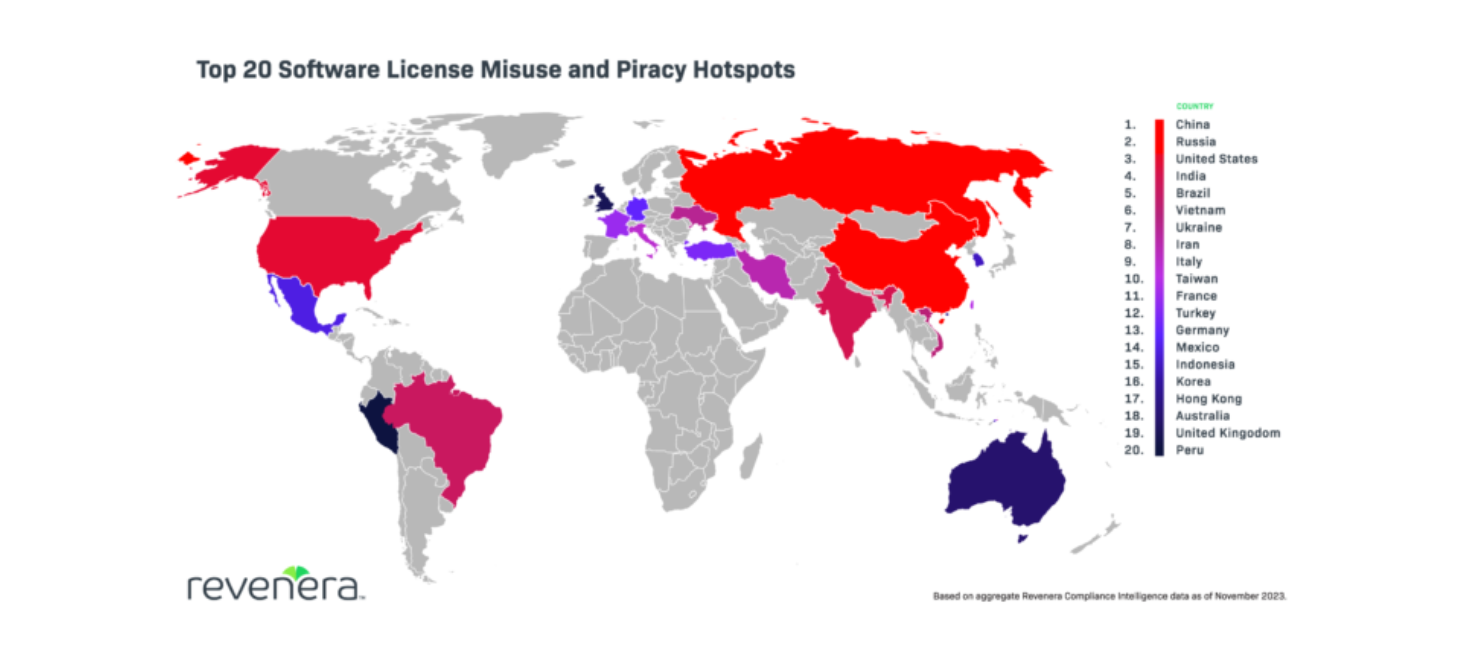
Digital Products Fraud Statistics

In 2023, more than 77% of chargebacks48 classified as fraud were friendly fraud.
Friendly fraud is when a customer disputes a charge for a digital product they have already received. This highly prevalent type of digital fraud results in costly transaction reversals and lost revenue for a merchant.
A 2022 report by Nsure49 found that:
- Digital currency gift cards were targets of fraud at 5x the typical rate.
- Downloads (apps and music) were targets of fraud at 3x the typical rate.
- Console games (Playstation, followed by Xbox and Nintendo) experienced fraud attacks at 2x the typical rate.
In 2020, monthly fraudulent transactions increased by 37%, almost double the rate of fraudulent transactions for physical-only goods.
US merchants selling digital goods were the hardest hit by these fraud attempts.
Sell Digital Products with Whop
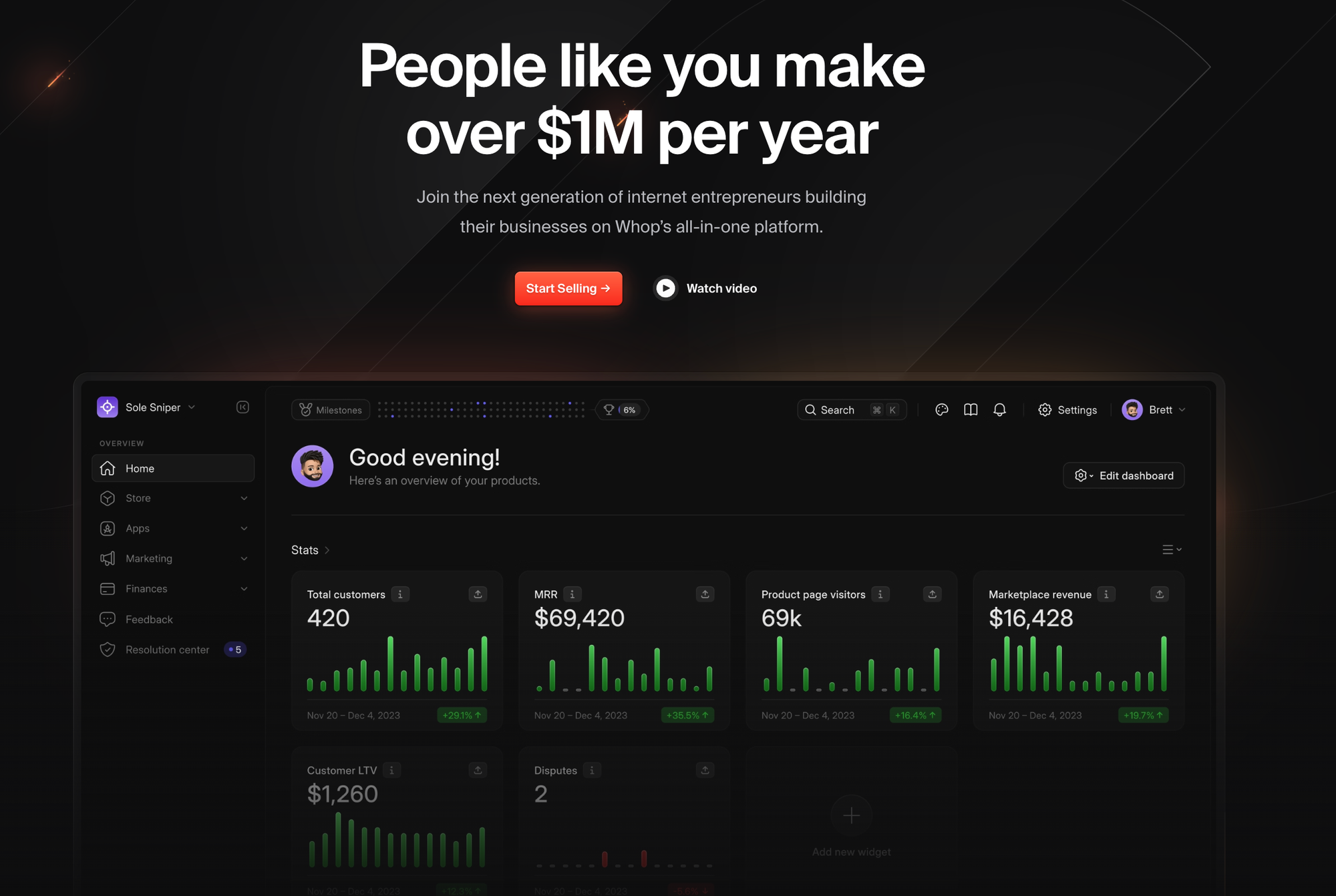
The market for digital products is growing at an incredible rate, with the volume of digital product transactions increasing by almost 70% in the past two years. It is expected that consumers will spend $135 billion on digital products this year alone - so why not harness this customer base by selling digital products yourself?
Whop is an online marketplace for digital products and is the perfect place for you to launch your business. With Whop, digital products are easy to create, sell, and manage.
It takes less than 10 minutes to get started as a seller on Whop, and Whop handles everything from order fulfillment, to payment processing, and helps with customer disputes.
Join this exciting market and explore the future of digital products - sign up as a seller on Whop today.
FAQs
How big is the market for digital products?
While it is difficult to say due to the fragmented nature of digital products, the market is massive, boasting an estimated worth exceeding $400 billion globally.
Can I make money selling digital products?
Yes, you can make money selling digital products. Not only are they highly profitable but digital products such as ebooks, online courses, or digital designs are scalable and can be produced without any additional financial or time investment.
What are examples of digital products?
Examples of digital products include ebooks, video games, music, movies, and apps – so, any intangible product that is distributed online.
Sources
Reference List
- Mastercard
- DataReportal
- McKinsey
- Business of Fashion
- Shop Circle
- Statista
- Statista
- Publishers Weekly
- Pew Research
- Statista
- Statista
- Statista
- Statista
- Statista
- Podcast Index
- Statista
- Reuters Institute
- Market US
- Statista
- Nielsen
- Statista
- GlobalNewswire
- Statista
- McKinsey
- Publishing Perspectives
- Statistics
- Fortune Business Insights
- Grandview Research
- Gartner
- PwC
- McKinsey
- Statista
- Statista
- Sensor Tower
- Grandview Research
- Statista
- Statista
- Statista
- Statista
- Deloitte
- Deloitte
- Meltwater
- Hubspot
- Hubspot
- DataReportal
- MUSO
- Revenera
- Kount
- Nsure





